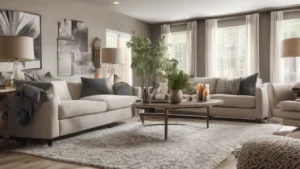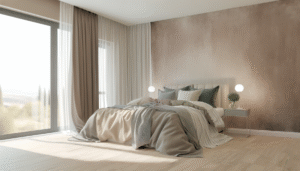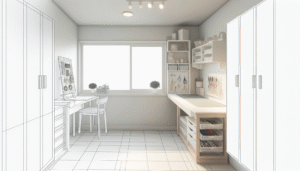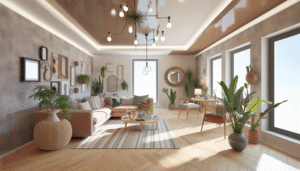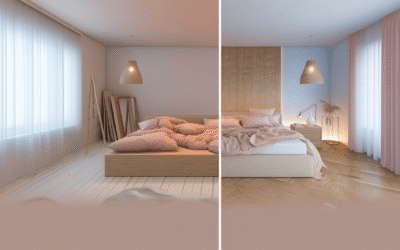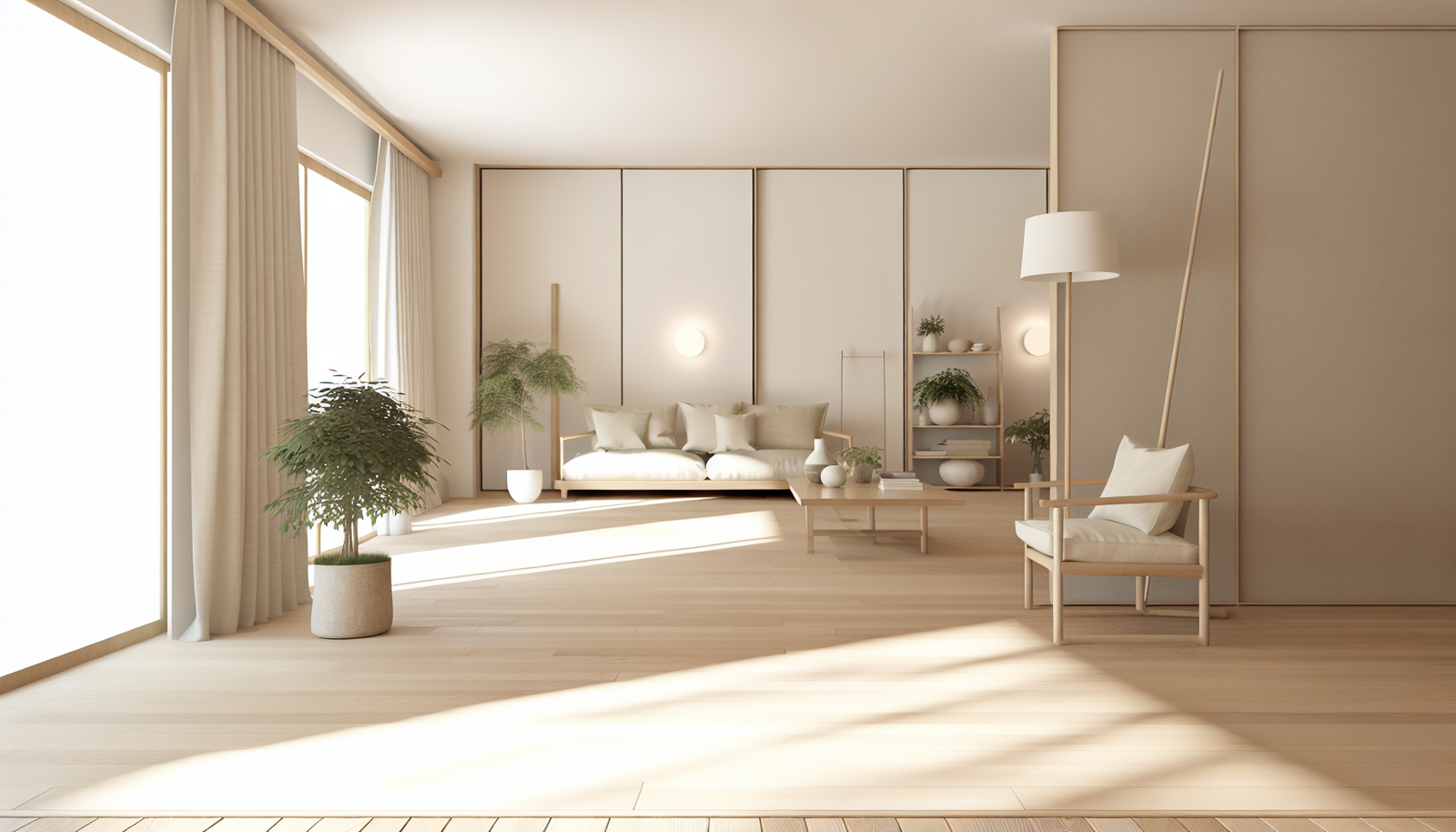
In our increasingly cluttered world, the desire for simplicity and tranquility has never been stronger. This longing often translates into our living spaces, driving us towards design philosophies that prioritize calm, functionality, and understated beauty. Enter Japandi minimalist style lighting fixtures – a design movement that has captured the hearts of homeowners and interior designers alike. Imagine stepping into a room where every element breathes harmony, where light isn’t just illumination but an integral part of the space’s serene narrative. This guide dives deep into how Japandi lighting can transform your home into such a sanctuary.
The fusion of Japanese aesthetics and Scandinavian functionality, Japandi, offers a unique blend of minimalist elegance. When it comes to lighting, this style isn’t just about choosing a lamp; it’s about crafting an ambiance. It’s about creating moments, not just bright spots. Throughout this detailed exploration, you will learn the core tenets of Japandi lighting, discover the ideal materials and forms, and gain actionable insights to integrate these exquisite pieces into your home. We’ll unveil how thoughtful lighting choices can enhance your well-being, optimize your daily routines, and imbue your space with a timeless, sophisticated calm. Get ready to illuminate your world, the Japandi way.
This article will guide you through understanding the philosophy behind Japandi lighting, exploring stunning design examples, and providing practical advice for selecting and placing fixtures. By the end, you’ll be equipped to create a home that truly reflects the serene elegance of Japandi style, making every corner a testament to peaceful living.
Understanding the Soul of Japandi Lighting: A Philosophy of Light and Simplicity
More than just a trend, Japandi is a design philosophy rooted in profound cultural concepts. Its approach to lighting is no exception. To truly appreciate Japandi minimalist style lighting fixtures, we must first understand the bedrock principles they stand upon: the Japanese concept of Wabi-Sabi and the Scandinavian idea of Hygge.
Wabi-Sabi: Embracing Imperfection and Nature’s Beauty
From the Japanese perspective, Wabi-Sabi celebrates beauty that is “imperfect, impermanent, and incomplete.” Applied to lighting, this translates to fixtures that often feature natural materials, raw textures, and subtle, earthy tones. Think about the soft glow emanating from a paper lantern, or the unique grain visible in a handcrafted wooden pendant. These aren’t about flashy perfection but about finding profound beauty in the authentic, the slightly asymmetrical, the gently weathered. It’s about light that feels organic, not manufactured.
- Natural Materials: Wood, bamboo, rice paper, ceramic, linen, woven fibers.
- Organic Forms: Shapes are often fluid, rounded, or abstractly inspired by nature.
- Understated Hues: Muted colors; off-whites, greys, soft greens, and natural wood tones.
- Embrace of Softness: Light output is rarely harsh; instead, it’s diffused, warm, and inviting.
Hygge: Crafting Cozy Comfort and Well-being
On the Scandinavian side, Hygge (pronounced “hoo-gah”) emphasizes creating warmth, comfort, and conviviality. In lighting design, Hygge means cultivating an atmosphere that fosters relaxation and connection. It’s about functional light that still feels incredibly welcoming. This often involves layering light sources, using dimmers, and ensuring that no single light source is overly bright or sterile. Japandi takes this quest for comfort and refines it with an intentional simplicity, ensuring that comfort never veers into clutter.
- Layered Lighting: Combining ambient, task, and accent lighting for depth.
- Warm Color Temperatures: Bulbs that emit a soft, yellowish glow (2700K-3000K).
- Functionality Meets Form: Practical designs that serve a purpose elegantly.
- Sense of Calm: Lights designed to de-stress and promote a peaceful environment.
The Japandi Synthesis: Minimalist Serenity, Maximized Impact
When Wabi-Sabi meets Hygge, Japandi lighting emerges. It’s a style that champions minimalism not for its starkness, but for its ability to clear visual noise and amplify beauty. These fixtures provide ample light while maintaining a sense of calm. They integrate seamlessly into a room, becoming quiet protagonists rather than shouting for attention. The result is lighting that feels both ancient and utterly contemporary, robust yet delicate, functional yet profoundly beautiful.
[IDEAL IMAGE: INFOGRAPHIC – “Japandi Lighting: The Fusion of Wabi-Sabi & Hygge” showing two converging streams of design principles (natural materials, earthy tones, imperfection) and (cozy comfort, layered light, functionality) meeting in the middle to form a unified Japandi aesthetic with examples of light fixtures.]
Understanding these foundational philosophies is crucial. It’s not about merely buying a “Japandi-looking” lamp, but about selecting a piece that embodies these values, transforming your space into a true haven.
Key Characteristics of Japandi Minimalist Style Lighting Fixtures
Identifying a true Japandi minimalist style lighting fixture goes beyond a quick glance. It involves discerning specific characteristics in materials, forms, and the quality of light it emits. These elements converge to define the distinctive serene and functional aesthetic.
Natural Materials: The Heart of Japandi
One of the most defining features of Japandi lighting is its reliance on natural, often raw or minimally processed materials. This choice is deliberate, connecting the indoor space to the natural world and celebrating the inherent beauty of each element.
- Wood and Bamboo: Dominant choices, often left in their natural finish or stained lightly. Oak, ash, and lighter woods are popular for their warmth and durability. Bamboo offers a lightweight, intricate alternative perfect for woven shades.
- Paper and Rice Paper: Evoking traditional Japanese lanterns, these materials provide a soft, diffused glow. They are incredibly lightweight and contribute to the ethereal quality of the light.
- Ceramic and Stone: Used for bases, shades, or sculptural elements. Their earthy textures and weight provide a grounded contrast to lighter materials.
- Linen and Cotton: Natural fabrics are favored for lamp shades, offering a soft diffusion of light and a tactile, inviting texture.
- Metal Accents: While less prominent, muted metals like matte black, brushed brass, or steel can be used sparingly for structural elements, adding a subtle industrial edge without overpowering the natural aesthetic.
The emphasis is on authenticity. You won’t find highly polished, glitzy, or synthetic materials here. The beauty lies in the material’s integrity.
Simple Forms and Clean Lines: Less is Truly More
Japandi lighting fixtures champion simplicity in design. Shapes are often geometric, organic, or a blend of both, but always free from excessive ornamentation. Functionality dictates form, leading to designs that are inherently elegant.
- Geometric Simplicity: Spheres, cylinders, cubes, or gentle conical shapes are common. These pure forms allow the material and light to be the focus.
- Organic Flow: Soft curves and shapes inspired by nature, like pebbles or elongated leaves, offer a fluid counterpoint to more rigid geometry.
- Minimalist Silhouettes: Fixtures are often lean and uncluttered, designed to disappear into the background when not lit, and to softly highlight their structure when illuminated.
- Absence of Embellishments: You won’t find crystals, elaborate carvings, or superfluous decorations. The design relies on inherent beauty, not applied ornamentation.
Subtle & Diffused Illumination: Crafting Ambiance
The quality of light emitted by Japandi fixtures is just as important as their physical form. It’s rarely direct or harsh; instead, it’s designed to create a soft, inviting atmosphere.
- Warm Color Temperatures: Light in the 2700K to 3000K range (warm white) is preferred. This mimics natural sunlight at dawn or dusk, promoting relaxation.
- Diffused Light: Shades made of paper, fabric, or frosted glass effectively soften the light, eliminating harsh shadows and glare.
- Layered Lighting: Japandi design encourages using multiple light sources at varying heights and intensities to create depth and flexibility in mood. Ambient, task, and accent lighting play distinct roles.
- Soft Glow: The goal is a gentle, ambient glow that envelops the space, rather than spotlighting specific areas with bright, focused beams (unless for specific tasks like reading).
These characteristics aren’t just aesthetic choices; they are functional decisions aimed at creating a harmonious, calming, and highly livable environment. When selecting Japandi minimalist style lighting fixtures, assess them against these criteria to ensure they truly embody the spirit of this serene design philosophy.
Types of Japandi Minimalist Style Lighting Fixtures for Every Room
Integrating Japandi minimalist style lighting fixtures throughout your home requires understanding the specific needs of each room and the types of fixtures best suited to meet those demands while upholding the aesthetic. From ambient to task lighting, Japandi offers elegant solutions.
Pendant Lights: Suspended Serenity
Pendant lights are perhaps the most iconic Japandi fixtures, often serving as focal points that hover gracefully in the air. They are versatile, perfect for ambient lighting, but also effective as task lighting over islands or dining tables.
- Dining Room Applications: A cluster of three bamboo pendants above a minimalist dining table, or a single oversized paper globe pendant creating a soft, inviting glow for meals.
- Kitchen Islands: Linear arrangements of smaller ceramic or wooden pendants can provide focused task lighting without overwhelming the space.
- Entryways: A striking, yet understated, large paper lantern can welcome guests with a warm, diffused light.
- Materials & Forms: Look for natural wood designs (light oak, birch), woven bamboo or rattan, rice paper globes, or muted ceramic shells. Shapes often include elongated cylinders, organic domes, or perfectly spherical forms.
- Example: The Akari light sculptures by Isamu Noguchi perfectly embody this spirit, offering a timeless blend of Japanese craftsmanship and minimalist design.
[IDEAL IMAGE: A minimalist dining area featuring a prominent Japandi-style rice paper pendant light (e.g., Noguchi-inspired Akari globe) suspended over a sleek, natural wood dining table.]
Floor Lamps: Grounded Illumination
Floor lamps in Japandi style provide crucial accent and ambient lighting, adding layers of warmth and height to a room’s illumination scheme. They often act as sculptural elements even when unlit.
- Living Room Comfort: A tall, slender wooden floor lamp with a linen shade placed next to a sofa creates a cozy reading nook or provides soft ambient light for conversation.
- Bedroom Ambiance: A subtle floor lamp with a diffused light source can offer a gentle glow, perfect for winding down in the evening.
- Materials & Forms: Slender wooden frames (tripod or straight pole) with fabric or rice paper shades. Some designs feature a direct light source reflected off a natural material or hidden within the base, casting an upward glow. Integrated shelving or tables are also common to maximize functionality.
- Pro Tip: Look for floor lamps with dimmer switches to easily adjust the mood of the room.
Table Lamps: Intimate Glows and Task Focus
Table lamps are essential for creating intimate pools of light, task illumination, and adding decorative accents on surfaces like side tables, consoles, or desks.
- Bedroom Nightstands: Minimalist ceramic lamps with natural linen shades, or small wooden base lamps that provide soft, indirect light, are ideal.
- Home Office Desks: A sleek, adjustable table lamp with a wooden or matte metal base can provide focused task lighting without visual clutter.
- Living Room Side Tables: A small, sculptural ceramic lamp can become a subtle art piece while offering a warm accent glow.
- Materials & Forms: Often feature ceramic or wooden bases paired with fabric or paper shades. Shapes are simple: stout cylinders, graceful curves, or unadorned blocks.
- Contrast: A darker ceramic base can provide a beautiful contrast to lighter Japandi furniture.
Wall Sconces: Subtle Architectural Highlights
Wall sconces in Japandi design are typically understated, meant to provide indirect ambient lighting or to highlight architectural features without being overly prominent themselves.
- Hallways & Corridors: Simple, discreet wall sconces that cast light upwards and downwards, creating a soft wash of light along the walls.
- Bedroom Accent: Placed above nightstands, minimalist sconces with diffused light can free up valuable surface space.
- Materials & Forms: Often made from matte metal (black or white), natural wood, or frosted glass. Designs are usually flush-mounted or have a very shallow profile, blending seamlessly into the wall.
- Placement: Consider placing them to highlight a unique texture on a wall or to provide guidance in a transitional space.
Recessed and Track Lighting: The Invisible Illumination
While often hidden, recessed and track lighting are crucial for achieving the clean, uncluttered look of Japandi design, providing versatile and powerful illumination without visible fixtures.
- General Ambient Lighting: Recessed lights provide functional, even ambient light across a room. They disappear into the ceiling, maintaining the minimalist aesthetic.
- Highlighting Features: Adjustable track lighting can be used to spotlight art, plants, or specific architectural elements, creating depth and focus.
- Kitchens & Bathrooms: Essential for functional task lighting in these highly utilized areas, often paired with warmer temperature bulbs for a softer effect.
- Seamless Integration: These options are favored for their ability to provide light without introducing visual “noise,” aligning perfectly with the Japandi principle of hidden functionality.
By thoughtfully combining these various types of Japandi minimalist style lighting fixtures, one can create a multi-layered lighting scheme that is both beautiful and highly functional, transforming every room into a haven of tranquility.
Crafting the Perfect Ambiance: Placement and Layering Strategies
The beauty of Japandi minimalist style lighting fixtures truly shines when integrated with a thoughtful lighting strategy. It’s not just about selecting individual pieces, but about how they interact to create a cohesive, inviting, and functional ambiance. The key lies in strategic placement and effective layering.
The Three Layers of Light: Ambient, Task, and Accent
A fundamental principle of good lighting design, and particularly crucial for Japandi, is to incorporate all three types of lighting to achieve depth and versatility.
- Ambient Lighting (General Illumination): This is the foundational layer, providing overall brightness for a room. It should be soft and diffused, avoiding harsh glares.
- Japandi Approach: Often achieved with large, central pendant lights (e.g., oversized paper lanterns), recessed lighting, or a combination of floor and table lamps that wash light across a wide area. Warm color temperatures are vital here.
- Goal: To ensure the room is comfortably lit for general movement and activity, creating a sense of openness and calm.
- Task Lighting (Functional Illumination): Focused light for specific activities, making tasks easier and preventing eye strain.
- Japandi Approach: Slender desk lamps, adjustable floor lamps next to reading chairs, or targeted pendants over a kitchen island. These fixtures should be functional but maintain a minimalist profile.
- Goal: To provide adequate illumination where needed without creating harsh spotlights or disrupting the overall peaceful ambiance.
- Accent Lighting (Highlighting & Mood): Used to draw attention to specific features, create visual interest, and add depth and drama to a space.
- Japandi Approach: Small, sculptural table lamps, wall sconces casting upward or downward light, or subtle track lighting pointed at artwork, plants, or textured walls. These often use lower wattage bulbs to create pools of soft light.
- Goal: To enhance the aesthetic of the room, define focal points, and add a cozy, intimate feel, reinforcing the Hygge element of Japandi.
Strategic Placement for Optimal Flow and Harmony
Where you place your Japandi lighting fixtures is as important as the fixtures themselves. Thoughtful placement can define zones, enhance architectural features, and improve the flow of a room.
- Varying Heights: Mix high (pendant), medium (floor lamp), and low (table lamp) light sources to create visual interest and prevent a flat, uninspired look.
- Defining Zones: Use a floor lamp and a small table lamp to delineate a reading nook within a larger living space. A pair of symmetrical pendants can frame a specific area.
- Minimizing Shadows: Cross-illuminate large rooms with multiple light sources to reduce harsh shadows and create a softer, more even light distribution.
- Highlighting Key Elements: Use accent lights to draw the eye to handcrafted pottery, a subtle piece of art, or a beautiful indoor plant, reinforcing the Wabi-Sabi appreciation for natural beauty.
- Considering Reflective Surfaces: Position lights to reflect off muted, natural surfaces (like light wood floors or matte walls) to enhance the diffused glow, rather than creating glare.
[IDEAL IMAGE: DIAGRAM – “Japandi Lighting Layering Strategy” showing a living room layout with icons for ambient (recessed/pendant), task (floor/desk lamp), and accent (small table lamp/sconce) lights, with arrows indicating light direction and interaction.]
Controlling the Mood: Dimmers and Smart Lighting
The ability to adjust light intensity is paramount in Japandi design, where mood and atmosphere are paramount. Dimmers are your best friend here.
- Dimmers on almost everything: Install dimmer switches on as many light sources as possible, especially ambient and accent lights. This allows you to transition the room from bright functionality to cozy intimacy with ease.
- Smart Lighting Systems: Consider smart bulbs or systems that allow you to control color temperature and brightness from your phone or voice assistant. This offers unparalleled flexibility in adapting your lighting to different times of day or activities, truly embodying the Hygge spirit.
- Warmth and Comfort: Remember, the goal is often a warm, inviting glow. Avoid clinical, cold white light. Japandi style uses light as a source of calm, not stimulation.
By mastering these placement and layering strategies, you can ensure that your Japandi minimalist style lighting fixtures don’t just illuminate your space, but actively contribute to its serene, harmonious, and highly livable character.
Choosing the Right Japandi Fixtures: Materials, Forms, and Retailer Insights
The selection process for Japandi minimalist style lighting fixtures can feel overwhelming with the myriad of options available. However, by focusing on key indicators and knowing where to look, you can confidently choose pieces that truly embody the aesthetic and elevate your home.
Material Focus: What to Look For (and Avoid)
As discussed, natural materials are fundamental. When making your selections, examine the quality and finish of these materials.
- Wood: Look for light-colored woods like oak, ash, birch, or natural bamboo. Finishes should be matte or semi-matte, showcasing the grain. Avoid highly lacquered, glossy, or heavily stained woods.
- Paper/Fabric: Rice paper should be taut and evenly diffused. Fabrics like linen or raw cotton should have a natural texture. Avoid synthetic-looking papers or shiny, overly processed fabrics.
- Ceramic: Opt for unglazed or matte-glazed ceramics with a natural, earthy feel. Subtle variations in texture or color are desirable (Wabi-Sabi). Avoid overly shiny, brightly colored, or mass-produced looking ceramics.
- Metal: When metal is present, it should be understated. Matte black, brushed brass, or muted bronze are good choices for accents. Avoid highly polished chrome, glittery finishes, or ornate metalwork.
A good rule of thumb: If a material looks like it grew from the earth or could gracefully age, it’s likely a good fit. If it looks purely manufactured and sterile, reconsider.
Form and Function: Simplicity Dictates Elegance
Japandi forms are clean and purposeful. Challenge ornate designs and unnecessary embellishments.
- Clean Lines & Geometric Shapes: Spheres, cylinders, and simple linear forms are cornerstones. The beauty lies in their purity.
- Organic Curves: Gentle, flowing curves inspired by nature are also Japandi-approved, especially for shades.
- Minimalist Structure: Ensure the fixture is structurally sound but visually light. Bulky bases or intricate decorative elements are usually out of place.
- Diffused Light Delivery: The primary function is to cast a soft, warm glow. Shades should effectively soften harsh light sources.
- Functionality: Consider adjustability, ease of cleaning, and compatibility with dimmer switches. A beautifully designed fixture that isn’t practical fails the Hygge test.
Where to Find Japandi-Inspired Lighting: Retailer Insights
Finding authentic Japandi fixtures requires knowing where to look beyond generic big-box stores. Here are some strategies and types of retailers:
- Specialty Lighting Boutiques: These stores often curate unique designs and have experts who can guide you. They might carry international brands that perfectly align with Japandi.
- Independent Artisans & Craftspeople: Websites like Etsy or local craft fairs can be treasure troves for handmade ceramic, wooden, or woven fixtures that embody Wabi-Sabi’s appreciation for craftsmanship and natural imperfections.
- Scandinavian Design Stores: Retailers specializing in Scandinavian furniture and decor will often have minimalist lighting options that blend seamlessly into a Japandi scheme. Think brands known for clean lines and natural materials.
- Japanese Homeware Stores: While some may be more traditional, many modern Japanese homeware brands offer minimalist lighting that champions natural materials and understated design.
- Online Retailers with Specific Filters: Major online home decor sites often have robust filtering options. Use keywords like “natural materials,” “minimalist,” “Scandinavian,” “Japanese,” “organic,” “wood,” “bamboo,” “rice paper” to narrow down selections. Always verify material descriptions and product images carefully.
- Vintage and Second-Hand: For true Wabi-Sabi, look for vintage pieces from the mid-century modern era (often Danish or Japanese in origin). The patina of age can add character.
Tool Recommendation: When browsing online, save images of fixtures you like to a Pinterest board or mood board. This helps you visualize how different pieces might work together and ensures consistency in your selection. Pay close attention to reviews, especially those mentioning material quality and light output.
[IDEAL IMAGE: COLLAGE – “Japandi Lighting Selection Guide” showing various materials and forms: a close-up of natural wood grain on a lamp base, a woven bamboo shade, the texture of a matte ceramic lamp, and the soft glow of a rice paper lantern.]
By being discerning about materials and forms, and knowing the best places to source your Japandi minimalist style lighting fixtures, you can ensure every light in your home is a testament to mindful design and serene living.
Japandi Lighting for Different Rooms: Tailoring the Glow
While the guiding principles of Japandi design remain consistent, the specific application of Japandi minimalist style lighting fixtures varies from room to room, adapting to each space’s unique function and desired mood. Let’s explore how to tailor your lighting choices for different areas of your home.
Living Room: Creating a Multi-Functional and Inviting Hub
The living room is often the heart of the home, requiring versatile lighting that can adapt from bright conversation to cozy relaxation.
- Ambient Foundation: A large, diffused central pendant (e.g., an oversized paper or linen globe) or recessed lighting on a dimmer provides the primary glow.
- Reading Nooks: A slender wooden floor lamp with a fabric shade, strategically placed next to a comfortable armchair, offers task lighting for reading.
- Accent & Warmth: Introduce small ceramic or wooden table lamps on side tables or console tables. These provide intimate pools of light, highlighting decorative elements or creating a gentle background glow.
- Consider Fireplace (if applicable): If you have a fireplace, ensure surrounding lighting enhances its warmth rather than competing with it. Subtle wall sconces can achieve this.
Dining Room: Setting the Scene for Connection
In the dining room, lighting plays a crucial role in creating an atmosphere conducive to shared meals and intimate conversations.
- Focal Pendant: A single, elegant pendant or a cluster of two or three smaller pendants suspended over the dining table is classic Japandi. Bamboo, wooden, or rice paper designs are perfect for providing a warm, diffused light that flatters both food and faces.
- Dimmers are a Must: The ability to dim the main dining light is essential for transitioning from family meals to romantic dinners.
- Subtle Wall Sconces: If space allows, muted wall sconces can add a soft ambient layer without distracting from the central pendant.
Bedroom: A Sanctuary of Rest and Calm
The bedroom demands lighting that promotes relaxation and a sense of calm, facilitating a peaceful transition from day to night.
- Soft Ambient Overhead: A fabric or rice paper flush mount or a small, diffused pendant provides gentle overall illumination.
- Bedside Task Lighting: Minimalist table lamps on nightstands (ceramic bases with linen shades) or discreet wall-mounted sconces free up surface space and offer direct reading light.
- Eliminate Glare: Ensure all bedroom light sources are diffused and avoid direct, harsh light. The goal is a soft, enveloping glow.
- Smart Lighting: Consider smart bulbs that allow for a gradual dimming feature to mimic a sunset, aiding in sleep preparation.
Kitchen: Functional Brilliance with Understated Style
Kitchens require strong, practical lighting, but Japandi ensures this functionality is met with elegance and calm.
- Task Lighting: Under-cabinet strip lighting (warm white) is essential for illuminating countertops. Recessed lighting provides excellent general task light evenly throughout the kitchen.
- Island Pendants: A row of two or three simple wooden or ceramic pendants over a kitchen island provides focused task lighting while adding a design statement.
- Sink Area: A small, practical wall sconce or a recessed light can be beneficial over the sink area.
- Pantry/Storage: Consider understated flush mounts or track lighting in pantries or utility areas.
[IDEAL IMAGE: FOUR-PANEL VISUAL – “Japandi Lighting by Room” showing distinct examples for Living Room (floor lamp, table lamp, ceiling light), Dining Room (pendants over table), Bedroom (bedside lamps, soft overhead), and Kitchen (island pendants, under-cabinet light).]
Bathroom: Serene and Practical
The bathroom needs efficient task lighting for grooming but also benefits from a serene, spa-like ambiance.
- Vanity Lighting: Instead of harsh overheads, consider vertical wall sconces with diffused light on either side of the mirror for even, shadow-free illumination.
- Ambient Comfort: A small, flush-mount fixture with a warm, soft glow provides general bathroom illumination.
- Natural Materials: Look for sconces with frosted glass and metal accents, or even a small wooden element, ensuring they are suitable for humid environments.
By thoughtfully considering the specific needs and desired mood of each room, you can select and place Japandi minimalist style lighting fixtures that transform your entire home into a cohesive and tranquil haven.
Case Studies: Japandi Lighting in Real-World Spaces
Theoretical concepts are essential, but seeing Japandi minimalist style lighting fixtures in action truly brings the philosophy to life. Let’s explore a few hypothetical case studies that illustrate how these principles translate into stunning, functional, and serene interior spaces.
Case Study 1: The Urban Apartment Sanctuary
Problem: Small living space, high ceilings, lack of natural light, and a desire for calm amidst city chaos.
Sarah, a graphic designer living in a compact city apartment, wanted her home to be a tranquil escape. The apartment had surprisingly high ceilings but limited square footage, making it challenging to introduce elements without creating clutter. Her goal was to maximize light and space efficiency while embracing a peaceful aesthetic.
- Living Area Solution: Sarah chose a large, drum-shaped pendant light crafted from natural linen for her main living area. Its diffused ambient light softened the high ceiling and created an immediate sense of warmth. Next to her sofa, a three-legged wooden floor lamp with a conical paper shade provided targeted reading light while acting as a subtle sculptural element. A small, matte black ceramic table lamp on her floating shelf offered a soft accent glow in the evenings.
- Dining Nook Solution: Over her small, round wooden dining table, a single, elongated bamboo pendant light (its natural weave adding texture) delivered focused yet gentle illumination, making the dining area feel intimate.
- Bedroom Solution: On either side of her low platform bed, she installed minimalist wall sconces with frosted glass and light wooden brackets. These provided soft, diffused bedside lighting without taking up precious nightstand space. An unobtrusive flush-mount fixture close to the ceiling offered general ambient light when needed.
Outcome: Sarah’s apartment was transformed. The varied lighting sources created depth and interest, making the small space feel larger and more intentional. The natural materials of the fixtures tied into her neutral color palette, cultivating a remarkably serene urban sanctuary.
Case Study 2: The Family Home with a Modern Twist
Problem: A busy family home needing durable yet stylish lighting, balancing functionality with a peaceful aesthetic, and accommodating diverse activities.
The Lees were a family of four in a modern, open-plan home. They wanted their lighting to be robust enough for daily family life, but also introduce a sense of calm and order that their existing mismatched fixtures lacked. They favored a Japandi look but needed practical solutions.
- Kitchen and Island Solution: Above their large kitchen island, they installed three elegant, cylindrical pendants with matte white ceramic shades. These provided excellent task lighting for cooking and homework. Recessed LED lights (warm white) throughout the kitchen provided ambient light, all connected to dimmers.
- Family Room Solution: For the main family room, a large, woven rattan pendant light served as the central ambient light, adding organic texture. Alongside, a sturdy wooden floor lamp with a thick linen shade was placed near the children’s play area, offering bright but diffused light. A pair of small, dark ceramic table lamps with subtle light patterns added warmth to a console table.
- Hallway Solution: Rather than bright overheads, the Lees opted for discreet, rectangular wall sconces that cast light upwards and downwards, creating subtle architectural interest and guiding visitors gently through the space.
Outcome: The Lees achieved a beautifully functional home. The Japandi lighting fixtures proved durable, integrated seamlessly into their modern architecture, and successfully introduced the desired tranquility. The layered approach allowed them to adjust the lighting for everything from active play to quiet family evenings.
Case Study 3: The Minimalist Home Office Retreat
Problem: Creating a productive, focused workspace that also feels calm and inspiring, avoiding harsh office-style lighting.
David, a remote worker, found his home office lacked inspiration and suffered from poor, clinical lighting. He wanted to design a space that supported deep work but also offered a peaceful environment for creative thinking.
- Desk Task Lighting: David chose a sleek, adjustable desk lamp with a light wooden arm and a matte black conical shade. This provided direct, glare-free task lighting without visual bulk.
- Ambient & Background: Instead of overhead fluorescent lights, he installed simple, flush-mount paper lanterns that cast a soft, even ambient glow across the room.
- Relaxation Corner: In a small corner dedicated to thought and relaxation, a tall, slender floor lamp with a natural linen shade created a warm pool of light next to a comfortable sling chair. The soft glow encouraged breaks and contemplation.
- Natural Elements: The inclusion of a small ceramic accent lamp near a collection of plants reinforced the connection to nature and Wabi-Sabi principles.
Outcome: David’s office transformed from a sterile workspace into a haven of productivity and calm. The Japandi lighting minimized eye strain, fostered focus, and created an environment that felt both inspiring and deeply peaceful, significantly improving his work-from-home experience.
These case studies demonstrate the versatility and impact of Japandi minimalist style lighting fixtures. They prove that with thoughtful selection and strategic placement, this design philosophy can genuinely enhance daily living in diverse settings.
Integrating Japandi Lighting with Other Design Elements
For Japandi minimalist style lighting fixtures to truly shine, they must be part of a cohesive design strategy. Their serene elegance is amplified when seamlessly integrated with other Japandi design elements, creating a harmonious and unified space.
Color Palette: Muted Tones as a Canvas
Japandi interiors embrace a serene, muted color palette that sets the perfect backdrop for minimalist lighting. Think about:
- Neutrals: Off-whites, creams, soft greys, and muted beiges form the foundation. These colors create a calming atmosphere and allow natural light to bounce beautifully.
- Earth Tones: Deep charcoals, forest greens, burnt oranges, and soft blues can be introduced as subtle accents through textiles, pottery, or a single piece of furniture, providing depth without distraction.
- Contrast: A darker feature wall or a black metal furniture frame can create a striking, yet minimalist, contrast against lighter walls and Japandi lighting.
Your lighting fixtures should complement, not clash with, this palette. Natural wood tones, whites, and blacks from the fixtures will seamlessly blend.
Furniture: Low-Profile and Functional
Japandi furniture shares the same principles of simplicity, natural materials, and functionality as the lighting.
- Low-Slung Pieces: Sofas, beds, and tables often have a low profile, emphasizing connection to the earth and creating a sense of spaciousness. Light fixtures that are suspended or tall and slender complement this low-level aesthetic.
- Natural Materials: Look for solid wood (oak, ash), rattan accents, and woven textures. These harmonize beautifully with wooden or bamboo lighting fixtures.
- Clean Lines: Furniture should feature straightforward, uncluttered lines, reflecting the minimalist forms of Japandi light fixtures.
- Multi-functional Pieces: A coffee table with integrated storage or a bench that doubles as shelving embodies the Japandi appreciation for clever, space-saving design.
Textiles: Touch and Texture
Textiles in a Japandi space add warmth and softness, embodying the Hygge aspect without introducing visual complexity.
- Natural Fibers: Linen, cotton, wool, and jute are preferred. These materials have subtle textures that add depth.
- Understated Patterns: Avoid busy patterns. If present, they should be simple geometric shapes or very subtle, organic motifs.
- Soft & Cozy: Throws, cushions, and rugs should invite touch and provide comfort. This creates a pleasing contrast with the often more structured light fixtures.
- Linen Lamp Shades: The use of linen in lamp shades directly ties into the textile choices across the room, reinforcing consistency.
Greenery: Bringing Nature Indoors
The Wabi-Sabi influence calls for a deep connection to nature, and plants are a simple yet powerful way to achieve this.
- Minimalist Plants: Opt for plants with architectural forms, such as snake plants, fiddle-leaf figs, or minimalist bonsais.
- Earthy Planters: Display them in ceramic, terracotta, or woven baskets.
- Strategic Placement: Use accent lighting (small track lights or upward-facing floor lights) to highlight your greenery, creating striking shadows and a dynamic display. The gentle light from a Japandi fixture can make a plant feel like a living sculpture.
Decluttering and Intentionality: The Japandi Ethos
Perhaps the most critical element of integration is the philosophy of less is more. For Japandi lighting to truly make an impact, the surrounding space must be uncluttered and intentional.
- Curated Objects: Each object in the room should have a purpose or be aesthetically pleasing. Avoid excessive ornamentation.
- Negative Space: Embrace empty spaces on walls and surfaces. These provide visual breathing room and allow the chosen fixtures and furniture to stand out.
- Mindful Living: The entire design encourages a mindful approach to living, where every element contributes to a sense of calm and well-being.
When you combine Japandi minimalist style lighting fixtures with a harmonious color palette, functional furniture, tactile textiles, and strategic greenery, you don’t just decorate a room; you curate an experience – a truly serene and inspiring living environment.
Maintenance and Care for Your Japandi Lighting Fixtures
The beauty of Japandi minimalist style lighting fixtures often lies in their natural materials and intricate details. Proper maintenance ensures their longevity and preserves their serene aesthetic. A little care goes a long way in keeping these pieces looking their best.
General Cleaning Guidelines
Regular, gentle cleaning is key to preventing dust buildup and maintaining the integrity of natural materials.
- Dusting: Use a soft, dry microfiber cloth or a feather duster for regular dusting. For delicate paper or fabric shades, a soft brush attachment on a vacuum cleaner (on low suction) can be effective.
- Wiping: For wooden or metal elements, a slightly damp cloth (water only, no harsh chemicals) can be used, followed immediately by a dry cloth to prevent moisture damage.
- Avoid Harsh Cleaners: Chemical cleaners can damage natural finishes, discolor paper, or strip protective coatings. Stick to simple soap and water (if suitable for the material) or specialized natural cleaners.
- Handle with Care: Especially with paper or delicate woven shades, avoid pressing too hard or bending materials.
Material-Specific Care Tips
Different natural materials require specific attention:
- Wood and Bamboo:
- Regularly dust to prevent buildup in grain.
- If wood feels dry over time, a natural wood wax or oil (e.g., beeswax, linseed oil) can restore its luster, but test on an inconspicuous area first.
- Protect from direct sunlight to prevent fading or warping.
- Paper and Rice Paper:
- Extremely delicate. Dust very gently.
- Avoid moisture at all costs, as it can cause warping or tearing.
- Keep away from areas with high humidity (e.g., directly above a shower, unless specifically designed).
- If a crease or minor tear occurs, sometimes a tiny dab of clear craft glue can fix it, but proceed with extreme caution.
- Linen and Fabric Shades:
- Vacuum with a brush attachment on low power.
- For minor spots, dab gently with a clean, damp cloth (water only) and blot dry. Test first.
- Avoid rubbing, as this can spread stains or damage the fabric weave.
- Ceramic:
- Most durable. Dust with a dry cloth.
- For smudges or dirt, a damp cloth with a mild soap solution can be used, then wipe dry.
- Matte finishes might show fingerprints more, so handle by the base.
- Metal Accents (Matte Black, Brushed Brass):
- Wipe with a soft, dry cloth.
- Avoid abrasive cleaners or polishers, which can damage the matte finish.
- For brushed brass, a gentle wipe with a solution of lemon juice and baking soda can restore shine if it has dulled, but always test discreetly.
Bulb Replacement & Electrical Safety
When replacing bulbs, always ensure the fixture is unplugged or the circuit breaker is off. Use the correct wattage and type of bulb specified by the manufacturer.
- LED Preference: LED bulbs are ideal for Japandi lighting due to their energy efficiency, long lifespan, and ability to emit warm, consistent light.
- Color Temperature: Stick to warm white (2700K-3000K) to maintain the cozy, inviting ambiance.
- Professional Check-ups: If you notice any flickering, unusual smells, or visible damage to wiring, consult a qualified electrician.
Addressing Damage and Wear (Wabi-Sabi Perspective)
While Japandi embraces imperfection, it doesn’t mean neglecting damage that could compromise functionality or safety.
- Minor Imperfections: A slight crease in paper, a faded spot on wood, or a subtle scratch can be seen as part of the Wabi-Sabi charm, telling a story of the object’s life.
- Structural Damage: Cracks in wood, significant tears in paper, or electrical issues should be addressed promptly by repair or replacement through a skilled craftsman or the original manufacturer.
By following these care guidelines, your Japandi minimalist style lighting fixtures will continue to illuminate your home with serene beauty for years to come, embodying the timeless spirit of enduring design.
FAQs about Japandi Minimalist Style Lighting Fixtures
What is Japandi lighting?
What materials are common in Japandi lighting fixtures?
How does Japandi lighting make a room feel?
Can I use Japandi lighting in a non-minimalist home?
What color temperature light bulbs should I use with Japandi fixtures?
Are Japandi lighting fixtures expensive?
How do I layer lighting in a Japandi style?
What’s the difference between Japandi and pure Scandinavian or Japanese lighting?
These FAQs cover common questions, helping readers deepen their understanding of Japandi minimalist style lighting fixtures and their integration into a harmonious living space.
Conclusion: Illuminating Your Path to Serenity with Japandi
As we’ve journeyed through the world of Japandi minimalist style lighting fixtures, it’s clear that this design philosophy offers far more than just aesthetic appeal. It’s an invitation to cultivate a deeper sense of calm, balance, and intentionality within your home. By thoughtfully integrating the core principles of Wabi-Sabi and Hygge into your lighting choices, you actively transform your living spaces into sanctuaries that nourish the soul and soothe the mind.
We’ve explored the profound influence of natural materials like wood, bamboo, and paper, the beauty found in simple, organic forms, and the critical role of soft, diffused light in creating an inviting atmosphere. From understanding the difference between ambient, task, and accent lighting to tailoring fixtures for specific rooms, the actionable insights provided here empower you to make informed decisions that resonate with the Japandi ethos. Remember, it’s not about grand gestures but about the subtle interplay of light and shadow, the tactile quality of natural textures, and the enduring elegance of simplicity.
The path to a Japandi-inspired home is one of mindfulness and deliberate choices. By embracing these principles, you’re not just buying lamps; you’re investing in an elevated way of living. So, take these insights, look around your home, and envision how a carefully chosen Japandi fixture can become a quiet protagonist, casting new light on your understanding of comfort, beauty, and tranquility. Let your home reflect the serene harmony of Japandi, one perfectly illuminated corner at a time. The journey to a more peaceful living space begins with conscious light.
Ready to Transform Your Space?
Begin by identifying one area in your home where you want to introduce a dose of Japandi serenity. Perhaps it’s a reading nook, your bedroom, or the dining area. Research specific Japandi minimalist style lighting fixtures that align with the principles discussed, paying close attention to materials and light quality. Experiment with dimmers and layering to experience the transformative power of mindful illumination.
For more inspiration and a curated selection of genuine Japandi home decor, consider exploring reputable design sources and specialized retailers. Your journey towards a harmoniously lit home is just beginning.
Explore More Japandi Decor Insights
Discover Natural Material Deep Dives
Learn About Core Lighting Principles
Content Disclaimer
Categories
- Accent Walls & Ceilings (61)
- Art Curation & Gallery (62)
- Bedding Style Trends (68)
- Bedroom Makeover (81)
- Bohemian & Eclectic Styles (58)
- DIY & Budget-Friendly Decor (63)
- Eco-Friendly Design (62)
- Furniture Care (71)
- Home Decor & Design Ideas (163)
- Home Wellness Spaces (59)
- Integrated Outdoor Living (67)
- Japandi Style (61)
- Kids and Nursery Decor (59)
- Living Room Decor (79)
- Mix & Match Techniques (73)
- Modern & Contemporary Design (66)
- Rug Sizing & Placement (73)
- Scandinavian Design Inspiration (12)
- Seasonal Home Decor (80)
- Small Space Solutions (73)
- Wall Art & Painting Tips (77)
Recent Comments
Archives
Product Gallery
-
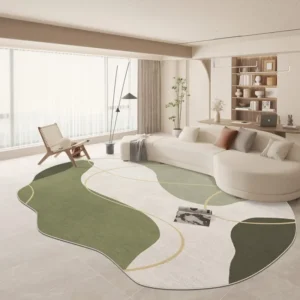 Large Area Green Rugs for Bedroom Nordic Living Room Decoration Shaped Carpet Irregular Plush Lounge Rug Home Thick Washable Mat
Rated 5.00 out of 5$54.94 – $346.41Price range: $54.94 through $346.41
Large Area Green Rugs for Bedroom Nordic Living Room Decoration Shaped Carpet Irregular Plush Lounge Rug Home Thick Washable Mat
Rated 5.00 out of 5$54.94 – $346.41Price range: $54.94 through $346.41 -
 Nordic Style Rugs for Bedroom Morandi Living Room Decoration Carpet Large Area Geometry Lounge Rug Home Cloakroom Non-slip Mat
Rated 5.00 out of 5$39.46 – $597.66Price range: $39.46 through $597.66
Nordic Style Rugs for Bedroom Morandi Living Room Decoration Carpet Large Area Geometry Lounge Rug Home Cloakroom Non-slip Mat
Rated 5.00 out of 5$39.46 – $597.66Price range: $39.46 through $597.66 -
 Irregular Shapes Living Room Decoration Carpet Modern Style Rugs for Bedroom Home Thicken Plush Rug Fluffy Soft Lounge Floor Mat
Rated 4.85 out of 5$55.84 – $347.37Price range: $55.84 through $347.37
Irregular Shapes Living Room Decoration Carpet Modern Style Rugs for Bedroom Home Thicken Plush Rug Fluffy Soft Lounge Floor Mat
Rated 4.85 out of 5$55.84 – $347.37Price range: $55.84 through $347.37

